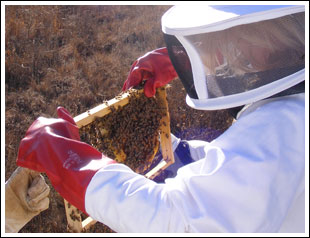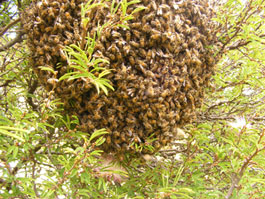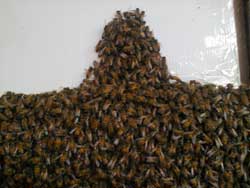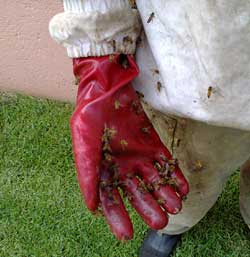 |
082 655 3463 sales@beeteam.co.za |
| Home About Bees Bee Removal Contact Us | |
Removing Honey BeesClick here to have an experienced bee specialist visit your property and remove bees There are a few things that can be expected from an ethical, humane bee remover, such as
Call us now on 082 655 3463It would be too simple to sum up our service in a short phrase. We remove bees. Given the sometimes delicate nature of such a task we like to explain the level of service we offer. Bees do on occasion take up residence in extremely difficult to reach places. Even the toxic practices of yesteryear fall short when one considers the problem of all the mess that would be left behind were one to simply poison a hive of bees. Removing the entire hive, bees, wax, honey and all is the only way to get the job done right, and that requires correct equipment, tools and techniques specifically designed for bee removal. Areas of OperationThe Bee Team operates in the following areas:
The cost involved in the removal of bees is significantly lower than that of extermination and one also avoids the inevitable unpleasantness of honey stains, thousands of bee corpses and the prospect of honey left in the hive attracting more bees. Saving the bees (even annoying ones) is the right way to go about this area of property and home maintenance in a less costly and more environmentally conscious manner. The Bee Team, as a company, are the best equipped and skilled people for the job. We also sell bees that are in a healthy condition, contact us for more details or visit our bees for sale webpage. Call us now on 082 655 3463Why it is better to have bees removed than try to exterminate them yourselfIt isn't news to anyone that the worlds bee population is dwindling at a rapid pace. It is also not news that if the bees become extinct the world will suffer a food shortage of epic proportions. We know that bees pollinate nearly two thirds of the plants that we use for food, and without pollination there wont be anything fresh to pick. Yes, the impact of disappearing bees will be felt within a season. On some farms, hives are kept on a permanent basis, allowing the bees to live their lives in peace while pollinating crops and supplying the farmer with honey. But, a frightening phenomenon has started to occur; these hive are being found completely empty, as if the bees packed up and left during the night. That bees will just leave their hive which is not under any threat and keeps farmers and bees happy is of major concern. There is speculation about what could be causing this and there is fear that poisons and insecticides used on crops are having a negative effect on the bees. Some fear that bees may be losing their sense of direction as a result of exposure and are unable to find the hive when out foraging. Farmers are cognisant of the damages of insecticides and most have changed the manner in which they deal with common pests which threaten their crops. Which is why the bees which we remove are rehoused and returned to places such as these farms. Yes we could rehouse them and keep them in our own gardens and have them pollinate our crops, but if truth be told, our crops in out gardens are too small to maintain bees for long and city living has more down sides for nature than living on a farm. Identifying a bee hive in the gardenIt is often difficult to identify a bee hive in the garden when there are hundreds of bees flying around. One sign that there is a bee hive in the garden is when the bees converge on one point and not on one plant or set of flowers. Watch the video below, pay careful attention because the bees are obviously very small and hard to see but you will notice that the bees are converging on their hive entrance in the bottom right hand corner of the screen.
Removing bees from a sign post in Sandton
When bees either abscond from their hive due to unfavourable conditions, or a colony splits and leaves the hive with the old queen which is called swarming, then you will sometimes see bees gathering on a tree, signboard, cars or just about any other item while the colony looks for a new hive. Fortunately we arrived before the swarm had flown off and managed to rehouse them in a proper Langstroth hive. This was a fairly straightforward job because we did not need to remove any honeycomb, which is very messy. Also, we did not need to reposition the brood comb- the comb which contains all the bee larvae.
Above right: bees on a signboard in Santon. You are welcome to use these photos for anything you want. Click on the photos to view the larger photo. This page was last updated on 5 December 2015 |
|

 All
bee removals differ. The African Honey Bee is an ingenious little marvel
of nature able to worm its way into almost any space. We find hives
in all sorts of awkward spots like airbricks, airvents, wendyhouses,
chimneys, under floorboards, under a roof, trees, rocks in the garden,
just about anywhere that has the right space available. We pride ourselves
on being able to apply our knowledge of this incredible insect to any
situation and achieve a positive result. We are not satisfied until
our job is done and the customers can carry on with their lives without
any further trouble from bees. The price of a standard bee removal is
around six hundred Rand, but the size of a job and its complexity vary
sufficiently that we do include additional fees given particular circumstances.
All
bee removals differ. The African Honey Bee is an ingenious little marvel
of nature able to worm its way into almost any space. We find hives
in all sorts of awkward spots like airbricks, airvents, wendyhouses,
chimneys, under floorboards, under a roof, trees, rocks in the garden,
just about anywhere that has the right space available. We pride ourselves
on being able to apply our knowledge of this incredible insect to any
situation and achieve a positive result. We are not satisfied until
our job is done and the customers can carry on with their lives without
any further trouble from bees. The price of a standard bee removal is
around six hundred Rand, but the size of a job and its complexity vary
sufficiently that we do include additional fees given particular circumstances. 
